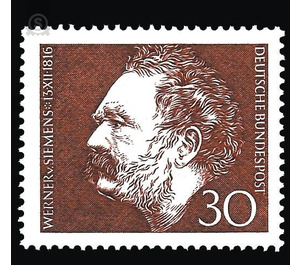100th birthday of Werner von Siemens - Germany / Federal Republic of Germany 1966 - 30 Pfennig
Theme: Calender
| Country | Germany / Federal Republic of Germany |
| Issue Date | 1966 |
| Face Value | 30.00 |
| Color | brown |
| Perforation | K 14 |
| Printing Type | Single-color Typography |
| Stamp Type | Postage stamp |
| Item Type | Stamp |
| Chronological Issue Number | 418 |
| Chronological Chapter | GER-BRD |
| SID | 985753 |
| In 62 Wishlists | |
Werner von Siemens was born on December 13, 1816 in Lenthe near Hannover and died on December 6, 1892 in Berlin. On the occasion of the 150th anniversary of the groundbreaking inventor, who opened the field of heavy current for application and utilization in everyday life, the Deutsche Bundespost is issuing the commemorative stamp. The graphic designers involved in the competition were given several portraits of different ages, because it seemed obvious to focus their artistic efforts on a portrait brand right from the start. Bert Jäger and the couple Hella and Heinz Schillinger each sent a draft. Two proposals were submitted by Prof. Karl Oskar Blase and Horst A. Rischka and three by Herbert Kern. The result was interesting in that it was undertaken with only a single work to illustrate electrical engineering instead of the portrait. In such an experiment, of course, one must work with highly abstracting graphic effects. The result can be interpreted ambiguously, because the nervous twitching of the line image can cause very different associations, depending on whether it is accompanied by seismographic, oscillographic or other meanings of a similar kind. Especially the consideration of this design led decisively and finally to the portrait. It is noticeable that of eight submitted works of this kind six bring the age portrait with the two-part white whiskers and the old-fashioned glasses, which has become well-known and downright popular since it graced a German banknote. A single artist used the side view, which shows Siemens almost in the pure profile as a man in the mature creative age. This head gives the gripping impression of concentrated energies and rushing Elans. The rousing momentum of bold inventiveness radiates from him. Herbert Kern has managed to give this portrait a firm shape, which makes the close affinity between the brand and the coin evident. It is an extraordinary stroke of luck when all preconditions come together to create such an immaculate and valid entity. The brand does not convince at first glance, not only by the speaking liveliness of the image of man. Rather, it is the surprisingly simple structure that banishes the viewer against his will. The head is slightly shifted to the right, in the center of gravity of the surface. In the triangular gusset, which releases the oblique neck, the numeral 30 is inserted organically with their juicy curves. The two delimiting text strips on the right and left, composed of noble antique verses, delimit the field of composition in well-balanced lengths. The Federal Minister for the Post and Telecommunications has followed the recommendation of the Art Advisory Board. The stamp is made in the Bundesdruckerei Berlin in monochrome intaglio and executed in a red color.


